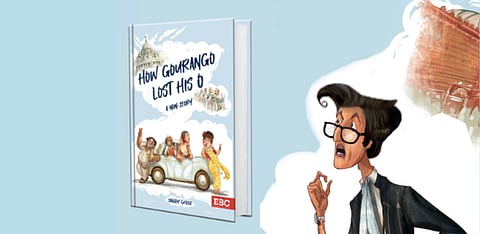

This book will be especially useful for those increasingly rare law students who opt for litigation over corporate practice.
———
SANJOY Ghose, the author of 'How Gourango Lost His O' ('HGLHO') calls it a non-story.
That is an apt description.
The book consists of a novella in two parts, and the third part consists of six short stories.
It is a collection of thinly disguised fictional pen-portraits of an interesting array of personalities the author has interacted with, and short stories pertaining to those who are featured.
The people who make up the cast of characters are all drawn from the categories which every practising lawyer deals with all the time viz. clients, lawyers, judges, and court staff. As the description also covers a bit of the protagonist Gourango's years as a law student, family, friends and mentors also come into the list of dramatis personae.
The device used to coalesce all these colourful characters into a single story is a dispute involving the fate of Noor Mallik, a teacher/Headmaster of a madarsa from the boondocks of the Sundarbans, and to trace its "progress" through the various stages of litigation (Part I) till it finally ends in the Supreme Court (Part II).
We meet Noor's indefatigable High Court lawyer Samar Bannerjee a.k.a. Keshto Da, his clerk Jobu and typist Shashi Babu, as also his wife Annapurna and daughter Sunanda a.k.a. Sunni.
As the case gets filed and progresses, we meet the judges who hear it, from Justice Parambrato Basak to the Appeal Bench of Justices Roopa Bose and Siddhant Jhunjhunwala. We also meet their families and staff members.
“The author comprehensively portrays various facets of practice in the High Court and Supreme Court from the viewpoint of a junior lawyer intimately involved in the process.
When the case moves to the Supreme Court we encounter the stories of Ali Khan, the Advocate on Record, and of Gourango's Senior Indumati Khilnani, who is a legendary lawyer and defender of the Constitution. By far, the longest story in the book is of Indumati and her circle.
The author has brought these characters to life, and the readers feel as if they are participants or witnesses in the action as it unfolds.
Noor's case is heard in the Supreme Court by a bench consisting of Justice Sreedharan Chandrashekharan Pandiyan and Justice Bipin Bihari Panda, and the readers are afforded a peek into their backgrounds too.
This device of devoting chapters to the characters who appear to play various roles in Noor's case enables the author to comprehensively portray various facets of practice in the High Court and Supreme Court from the viewpoint of a junior lawyer intimately involved in the process.
In all this, the hero, Gourango Ghose is the common element. It is he who tells us each story like a skilled story-teller.
After Noor's case is done and dusted, the later stories are not related to the main thread of his case and can easily be read as stand-alone short stories.
The book has been edited by Supriya Malik, and it is possible that Part III, containing six separate short stories has been added, along with a list of characters in order of appearance at the outset and a Glossary of Legal Terms at the end, to pad up the hardcover edition to achieve the standard word length of a novel.
Even so, this novel of just about 200 pages can easily be fully read and enjoyed over a weekend.
I enjoyed reading HGLHO because it is narrated by an insider in a most readable style of writing. Although lawyers are familiar with the processes described, they will not get bored. For the general reader hoping to read a regular novel, the appeal of the book may be different.
Since it is meant not just for law-connected readers but for the general public, care has been taken by the editor to simplify the legal concepts within the text with reference to the context which may seem too elementary for readers possessing a legal background. But for anyone wanting to get a fairly accurate description of the "practice" of law in Indian high courts and the Supreme Court, this "novel" is a welcome crash-course by an accomplished insider who has been there and done that.
This book will be especially useful for those increasingly rare law students who opt for litigation over corporate practice.
Not surprisingly, Sanjoy Ghose has dedicated it to "every struggling lawyer".
“ It will be very profitable for new entrants into the legal field to read such books and enrich themselves by a wealth of anecdotal experience shared by those who have trudged the path.
Though it is not a comic tale or a funny book, there is enough underlying humour in the author's narrative style to keep the atmosphere light. Sample this:
"In Delhi, many lawyers will confess to you that the fancy address, the jazzy office, the way-more-than-one-can-afford-car on an EMI, were all essential facets to make a lawyer presentable to his client and even impress the court. In Calcutta, the Marwari seths, who mostly patronised the lawyers, were too clever to care – they knew that any extra accompaniment on a lawyer's person would somehow willy-nilly find its way into their invoice. So, it was simple, cut the snazzy office and expensive car. I do not want this added to my legal fees!"
The book is Eastern Book Company's first foray into publishing a fictional work, and the hardbound edition is attractively presented.
At Rs. 695, the price, however, is on the higher side.
I hope a paperback edition at a price affordable to law students follows soon as I feel it will be very profitable for new entrants into the legal field to read such books and enrich themselves by a wealth of anecdotal experience shared by those who have trudged the path.